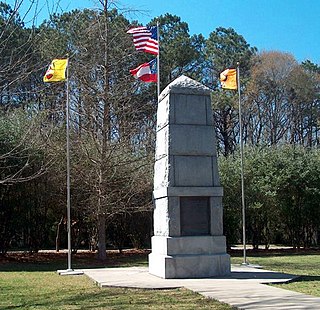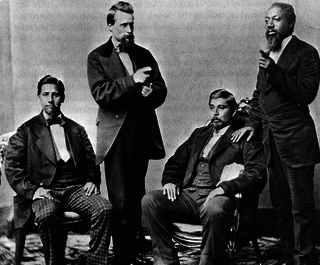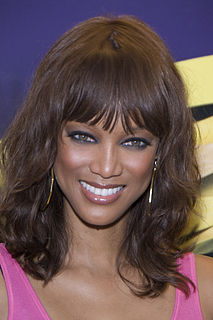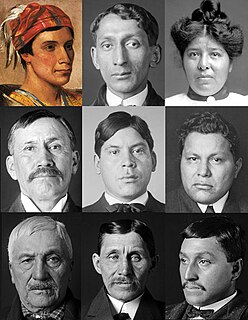
The Trail of Tears was a series of forced relocations of Native Americans in the United States from their ancestral homelands in the Southeastern United States, to areas to the west that had been designated as Indian Territory. The forced relocations were carried out by government authorities following the passage of the Indian Removal Act in 1830. The relocated peoples suffered from exposure, disease, and starvation while en route to their new designated reserve, and many died before reaching their destinations. The forced removals included members of the Cherokee, Muscogee (Creek), Seminole, Chickasaw, and Choctaw nations, as well as their African slaves. The phrase "Trail of Tears" originates from a description of the removal of many Native American tribes, including the infamous Cherokee Nation relocation in 1838.
Chief Buffalo Child Long Lance, born Sylvester Clark Long, was an American journalist, writer and actor from Winston-Salem, North Carolina who, for a time, became internationally prominent as a spokesman for Indian causes. He published an autobiography, purportedly based on his experience as the son of a Blackfoot chief. He was the first presumed Native American admitted to the Explorers Club in New York City. In reality a non-Native, he had claimed to be of mixed Cherokee, white and black heritage, at a time when Southern society imposed strict binary divisions of black and white in a racially segregated society. After his tribal claims were found to be false, he was dropped by these same social circles to which he had gained entry.
The Dawes Rolls were created by the United States Dawes Commission. The Commission was authorized by United States Congress in 1893 to execute the General Allotment Act of 1887.

The Natchez are a Native American people who originally lived in the Natchez Bluffs area in the Lower Mississippi Valley, near the present-day city of Natchez, Mississippi in the United States. They spoke a language with no known close relatives, although it may be very distantly related to the Muskogean languages of the Creek Confederacy.

Blood quantum laws or Indian blood laws are laws in the United States and the former Thirteen colonies that define Native American identity by percentages of ancestry. These laws were enacted by the American government, and many tribes and nations do not include Blood Quantum (BQ) as part of their enrollment criteria.
Black-Dutch is a term with several different meanings in United States dialect and slang. It generally refers to racial, ethnic or cultural roots. Its meaning varies and such differences are contingent upon time and place. Several varied groups of multiracial people have sometimes been referred to as or identified as Black-Dutch, most often as a reference to their ancestors.
Racial passing occurs when a person classified as a member of one racial group is accepted as a member of a racial group other than their own. Historically, the term has been used primarily in the United States to describe a person of color or multiracial ancestry who has assimilated into the white majority during times when legal and social conventions of hypodescent classified the person as a minority, subject to racial segregation and discrimination, regardless of their actual ancestry.
Martha Redbone is an American blues and soul singer of part Cherokee, Choctaw, European and African-American descent. She has won awards for her contemporary Native American music. Her music is a mix of rhythm and blues, and soul music influences, fused with elements of traditional Native American music.
The Cherokee Freedmen Controversy was a political and tribal dispute between the Cherokee Nation of Oklahoma and descendants of the Cherokee Freedmen regarding the issue of tribal membership. The controversy had resulted in several legal proceedings between the two parties from the late 20th century to August 2017.
The Choctaw freedmen were indigenous people of color who were granted citizenship in the Choctaw Nation. Their freedom and citizenship were requirements of the 1866 treaty the US made with the Choctaw; it required a new treaty because the Choctaw had sided with the Confederate States of America during the war. The Confederacy had promised the Choctaw and other tribes of Indian Territory a Native American state if it won the war.
Multiracial Americans are Americans who have mixed ancestry of two or more races. The term may also include Americans of mixed race ancestry who self-identify with just one group culturally and socially. In the 2010 US census, approximately 9 million individuals or 2.9% of the population, self-identified as multiracial. There is evidence that an accounting by genetic ancestry would produce a higher number. Historical reasons, including slavery creating a racial caste and the European-American suppression of Native Americans, often led people to identify or be classified by only one ethnicity, generally that of the culture in which they were raised. Prior to the mid-20th century, many people hid their multiracial heritage because of racial discrimination against minorities. While many Americans may be considered multiracial, they often do not know it or do not identify so culturally, any more than they maintain all the differing traditions of a variety of national ancestries.

The American Civil War saw Native American individuals, bands, tribes, and nations participate in numerous skirmishes and battles. Native Americans served in both the Union and Confederate military during the American Civil War. They were found in the Eastern, Western, and Trans-Mississippi Theaters. At the outbreak of the war, for example, the majority of the Cherokees sided with the Union, but soon after allied with the Confederacy. Native Americans fought knowing they might jeopardize their sovereignty, unique cultures, and ancestral lands if they ended up on the losing side of the Civil War. 28,693 Native Americans served in the Union and Confederate armies during the Civil War, participating in battles such as Pea Ridge, Second Manassas, Antietam, Spotsylvania, Cold Harbor, and in Federal assaults on Petersburg.

Slavery among Native Americans in the United States includes slavery by Native Americans as well as slavery of Native Americans roughly within the present-day United States. Tribal territories and the slave trade ranged over present-day borders. Some Native American tribes held war captives as slaves prior to and during European colonization, some Native Americans were captured and sold by others into slavery to Europeans while others were captured by Europeans and sold into slavery, and a small number of tribes, in the late eighteenth and nineteenth centuries, adopted the practice of holding slaves as chattel property and held increasing numbers of African-American slaves.
The Native Writers' Circle of the Americas (NWCA) is an organization of Native American writers, most notable for its literary awards, presented annually to Native American writers in three categories: First Book of Poetry, First Book of Prose, and Lifetime Achievement. The awards are voted upon by Native American writers, making it one of the few literary awards presented to Native Americans by Native Americans.

African slaves were owned by Native Americans from the colonial period until the United States' Civil War. The interactions between Native Americans and African Slaves in the antebellum United States is complex, given that slavery played a significant role in the creation and construction of America. This slavery institution relied largely on the enslavement of Africans and Native Americans owned by white European colonists and later white Americans after the United States gained independence from Great Britain.














